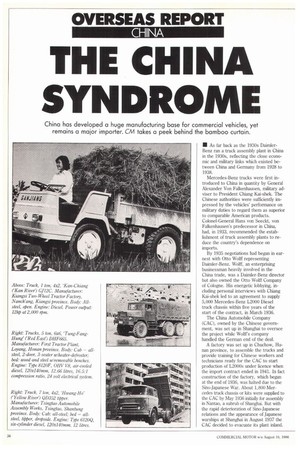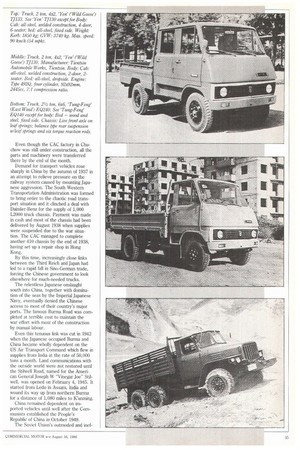TN CHINA SYNDROME
Page 36

Page 37

Page 38

If you've noticed an error in this article please click here to report it so we can fix it.
China has developed a huge manufacturing base for commercial vehicles, yet remains a major importer. CM takes a peek behind the bamboo curtain.
• As far back as the 1930s DaimlerBenz ran a truck assembly plant in China in the 1930s, reflecting the close economic and military links which existed between China and Germany from 1928 to 1938.
Mercedes-Benz trucks were first introduced to China in quantity by General Alexander Von Falkenhausen, military adviser to President Chiang Kai-shek. The Chinese authorities were sufficiently impressed by the vehicles' performance on military duties to regard them as superior to comparable American products. Colonel-General Hans von Seeckt, von Falkenhausen's predecessor in China, had, in 1933, recommended the establishment of truck assembly plants to reduce the country's dependence on imports.
By 1935 negotiations had began in earnest with Otto Wolff representing Daimler-Benz. Wolff, an enterprising businessman heavily involved in the China trade, was a Daimler-Benz director but also owned the Otto Wolff Company of Cologne. His energetic lobbying, including personal interviews with Chiang Kai-shek led to an agreement to supply 5,000 Mercedes-Benz L2000 Diesel truck chassis within five years of the start of the contract, in March 1936.
The China Automobile Company (CAC), owned by the Chinese government, was set up in Shanghai to oversee the project while Wolff's company handled the German end of the deal.
A factory was set up in Chuchow, Hunan province, to assemble the trucks and provide training for Chinese workers and technicians ready for the CAC to start production of L2000s under licence when the import contract ended in 1941. In fact construction of the factory, which began at the end of 1936, was halted due to the Sino-Japanese War. About 1,800 Mercedes truck chassis or kits were supplied to the CAC by May 1936 initially for assembly in Nantao, a subrub of Shanghai. But with the rapid deterioration of Sino-Japanese relations and the appearance of Japanese warships at Shanghai in August 1937 the CAC decided to evacuate its plant inland. Even though the CAC factory in Chuchow was still under construction, all the parts and machinery were transferred there by the end of the month.
Demand for transport vehicles rose sharply in China by the autumn of 1937 in an attempt to relieve pressure on the railway system caused by mounting Japanese aggression. The South Western Transportation Administration was formed to bring order to the chaotic road transport situation and it clinched a deal with Daimler-Benz for the supply of 1,000 L2000 truck chassis. Payment was made in cash and most of the chassis had been delivered by August 1938 when supplies were suspended due to the war situation. The CAC managed to complete another 410 chassis by the end of 1938, having set up a repair shop in Hong Kong.
By this time, increasingly close links between the Third Reich and Japan had led to a rapid fall in Sian-German trade, forcing the Chinese government to look elsewhere for much-needed trucks.
The relentless Japanese onslaught south into China, together with domination of the seas by the Imperial Japanese Navy, eventually denied the Chinese access to most of their country's major ports. The famous Burma Road was completed at terrible cost to maintain the war effort with most of the construction by manual labour.
Even this tenuous link was cut in 1942 when the Japanese occupied Burma and China became wholly dependent on the US Air Transport Command which flew in supplies from India at the rate of 50,000 tons a month. Land communications with the outside world were not restored until the Stilwell Road, named for the American General Joseph W "Vinegar Joe" Stilwell, was opened on February 4, 1945. It started from Ledo in Assam, India and wound its way up from northern Burma for a distance of 1,080 miles to K'unming.
China remained dependent on imported vehicles until well after the Communists established the People's Republic of China in October 1949.
The Soviet Union's outmoded and inef ficient industrial policies became a model for China's infant motor vehicle industry from the 1950s because of the Americaninspired trade embargo placed on China in the wake of the Korean War. A trickle of modern machinery, including cars and trucks, reached the PRC from Western Europe when economic and political conditions improved in the mid-1950s, but the West was reluctant to supply the kind of turnkey projects that China needed.
As a result China continued to produce limited numbers of Soviet-designed trucks and buses, generally of indifferent quality, well into the 1970s. It is only in the 1980s that serious efforts have been made to modernise and rationalise China's automotive industry, sometimes in partnership with American and European firms, harking back to the time when that first handful of Mercedes trucks left the Nantao workshop half a century ago.
The PRC produced 439,000 motor vehicles — 80% of them trucks — in 1985 but continues to rely heavily on imports. Some of the main foreign types in use since the 1950s are as follows:
0 CZECH: Skoda and Skoda/LIAZ 706series buses, coaches and trucks; Tatra 1,111-, T138and 1'148-series 6x6 trucks.
LI FRENCH: Berliet Gal and GBCM8T 6x 6 military trucks.
Ei EAST GERMAN: IFA W50L-series 4 x 2 and 4x4 trucks_
111 WEST GERMAN: Daimler-Benz sold 3,910 assorted commercial vehicles to the PRC between 1945 and 1983.
['JAPAN: Toyota Hi-Ace series minibuses, Hi-Lux pickup trucks; equivalent vehicles from Nissan and other manufacturers; Isuzu TDand TX-series 4 x 2 trucks; 5,842 faulty Mitsubishi trucks (later replaced by manufacturers with new ones in 1985) all from 1972 onward.
0 USSR: GAZ 51/A/B, GAZ 53, MAZ 500-series and ZIS/ZIL 157-series 4x2, 4x4 and 6x6 trucks.




































































